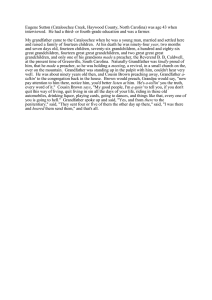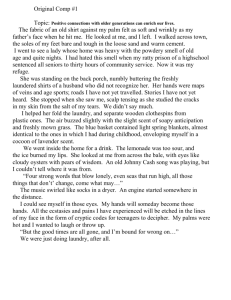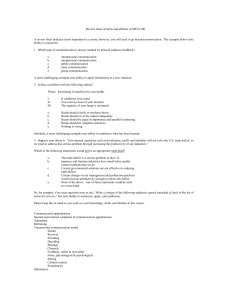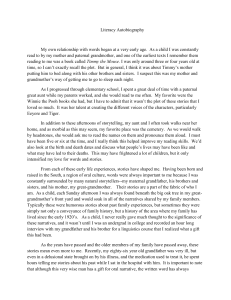Organizing Your Speech
advertisement
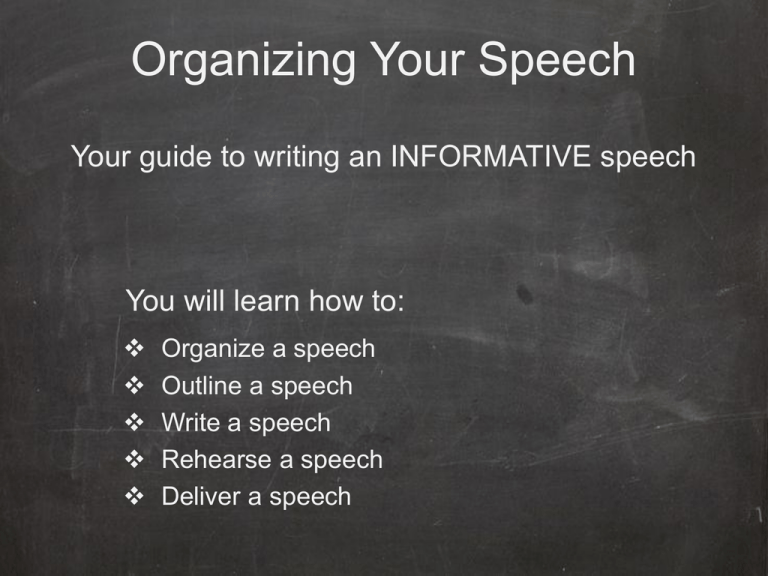
Organizing Your Speech Your guide to writing an INFORMATIVE speech You will learn how to: Organize a speech Outline a speech Write a speech Rehearse a speech Deliver a speech Aristotle’s Pathos, Ethos, & Logos Logical Appeal (Logos) The speaker offers an organized, clearly defined speech containing solid reasoning and valid evidence. Use facts, statistics, quotations, and expert opinion. Be a speaker who people want to listen to. Aristotle’s Pathos, Ethos, & Logos Emotional Appeal (Pathos) The speaker’s words arouse feelings in the audience, like anger, disgust, and compassion. Use stories, vivid descriptions, empathy, and sympathy. Be a speaker who people want to listen to. Aristotle’s Pathos, Ethos, & Logos Personal Appeal (Ethos) The speaker wins the audience’s trust through honesty, competency, and credibility. Use credibility, education, poise, confidence, and appearance. Be a speaker who people want to listen to. Writing an Outline An outline is: The speaker’s map A logical, organized framework for your speech. A guide for how your speech will progress. What does speech need? The Three Musts For All Speeches: ①An introduction ②A Body ③A Conclusion Find this checklist on your worksheet: Step 1: Determine what type of speech you will be preparing Step2: Choose a topic Step 3: Create a purpose statement Step 4: Create an introduction Step 5: Create a body Step 6: Create a conclusion Step 7: Practice and time your speech Step 8: Present your speech You will be doing these steps in order as you continue through this process. This will help you prepare. After all, PREPARATION is the key to SUCCESS! Step 1: The Tribute Speech Type of Speech: Informative Goal: To inform your audience about someone who has been important in your life Step 2: Choose a topic On your worksheet, take 2-3 minutes to brainstorm ideas for this speech. (You may use your phones to time yourselves. Set a timer or use the stopwatch. REMEMBER: Manage your time wisely.) Who will you be speaking about in your speech? Step 3: The Purpose Statement The purpose statement states your selected speech topic and your specific purpose of speaking. Example: The purpose of this speech is to inform the audience about my grandfather and the positive impact he had on my life. Step 3: The Purpose Statement Take 2-3 minutes to develop and write your purpose statement on your outline. (REMINDER: As you come to the Stop Signs, you may use your phones to time yourselves in order to manage your time wisely. Set a timer or use the stopwatch. ) Step 4: The Introduction The Introduction includes: The Attention-Getter A link The Thesis Statement (also called a Purpose Statemen The Preview Statement Step 4: The Introduction Attention-Getter You MUST grab the attention of your audience with the attention-getter. THIS IS THE FIRST THING YOU SAY IN A SPEECH! There are four types of attention-getters: 1. Startling Statement or Statistic 2. Quote 3. Story 4. Asking questions Example: Someone once said, “Grandpas may be old on the outside, but they are still young on the inside.” Step 4: The Introduction Take 2-3 minutes to develop and write your attention-getter for your speech. Write the attention getter on Roman numeral “I” on your outline. Step 4: The Introduction Link The link logically connects the attention-getter to the thesis statement. It also develops a bridge between the audience and the topic. Example: This is true about my grandfather. He is young on the inside, even though he may seem old on the outside. Step 4: The Introduction Take 2-3 minutes to develop and write your link for your speech. Write the link on “A” below your attention-getter on your outline. Step 4: The Introduction Thesis Statement The thesis statement, or statement of purpose, is a positive statement about your topic. It tells the audience exactly what you will be speaking about. Example 1: I would like to discuss my grandfather and the positive impact he has had on my life. Example 2: Today I will tell you about my grandfather and how he has impacted my life. Example 3: My grandfather has made a positive impact on my life. Step 4: The Introduction Take 2-3 minutes to develop and write your thesis/purpose statement. Write it on “II” below your link on your outline. Step 4: The Introduction Preview Statement The preview statement is usually one sentence at the end of the introduction that gives the audience an overview of the major areas that will be discussed in the body of the speech. We will break this down into three main points for this speech. Example: A. My grandfather has been a good influence to his grandchildren. B. He has shown us the value of education. C. He has helped his grandchildren with many things. Step 4: The Introduction Take 4-5 minutes to develop and write your preview statement. Write it on “A, B, and C” below your thesis statement on your outline. Step 5: The Body The Body includes: Main points/headings Supporting Material Details Step 5: The Body Main points/Headings The main headings represent the main ideas you wish to present. Example: I. My grandfather has been a good influence to his grandchildren. II. He has shown us the value of education. III. He has helped his grandchildren with many things. Step 5: The Body Take 2 minutes to copy your main points from your introduction into the body of your outline. You will write them behind Roman numerals I, II & III. Step 5: The Body Supporting Material Supporting material provides intensification and reinforcement for the main headings. Example: I. My grandfather has been a good influence to his grandchildren. a) He is a hard worker. b) He taught us the importance of hard work. Step 5: The Body Take 5-6 minutes to develop and write your supporting material on your outline. You will write them on lines A & B below each of the main points. Step 5: The Body Details Details narrow the outline even further, providing information that breaks down the supporting material to pinpoint accuracy. Example: I. My grandfather has been a good influence to his grandchildren. a) He is a hard worker. 1. My grandfather comes from a poor family and he worked hard to become educated. He was in the military when he was young, and this helped him get his degree. This taught me to work hard, no matter what circumstances life gives you. Step 5: The Body Take 5-6 minutes to develop and write some of your details on your outline. You will write them on lines 1 & 2 below each of the supporting materials. Step 6: The Conclusion The Conclusion wraps up the speech in a neat communication package. The Conclusion includes: A summary of the main points Important details or supporting material Final clincher Step 6: The Conclusion Summary of the main points Repeat your three main points. Example: My grandfather has been a good influence to his grandchildren, he has shown us the value of education, and he has helped his grandchildren with many things. Step 6: The Conclusion Take 2-3 minutes to write the summary of your main points in your conclusion. of your details on your outline. Step 6: The Conclusion Important Details/Supporting Material Restate the details or supporting materials you think is super important. Example: My grandfather has been a good influence to his grandchildren, he has shown us the value of education, and he has helped his grandchildren with many things. a) I have been taught many valuable lessons from my grandfather. b) I hope you have a grandpa like mine, and if you don’t, I hope that someday you will be a grandfather line mine. Step 6: The Conclusion Take 3-4 minutes to write the important details/supporting material in your conclusion. Don’t restate what you have already said. Try saying it in a different way. Step 6: The Conclusion Final Clincher The Final Statement ends your speech, clinches your argument, and makes a memorable final impression. Example: So even though my grandfather looks old on the outside, he is and will always be young on the inside. Step 6: The Conclusion Take 3-4 minutes to develop and write the final clincher in your conclusion. Be creative! This will help you make a lasting impression on your audience. Before you move on to the final two steps of the process: Have you done the following with your speech: Read for grammar, spelling, punctuation? Read for clarity of message? (will the audience understand) Restated ideas in different words? (avoid repeating yourself) Filled in your outline entirely? Spend about 10 minutes cleaning up/finishing up your speech. It is always good to go back and proofread! Step 7: Practice and Time Practice and time yourself! Fill out the practice log. Practice for your parents and have them sign your speech handout. Your speech must be 2-4 minutes. REMEMBER: Preparation is the key to success! Step 8: Present your speech SPEECHES ARE DUE Next Monday/Tuesday. We will begin presenting them in class on that day. Come to class prepared to deliver your speeches! Have your speeches and completed practice log.
